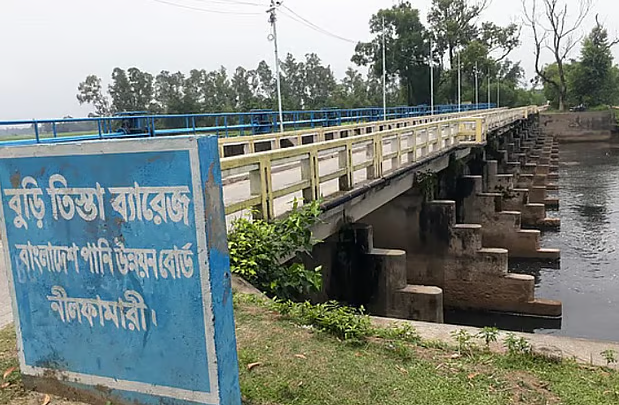A branch of the Karatoya River in Debiganj Upazila of Panchagarh enters through Shaldanga Union and joins the Teesta River upstream at Laxminarayani/Mallikadaha village of Sundardighi Union. Especially during Mahalaya, local Hindus used to perform various religious rituals including Pitru Paksha, Tarpan, Shraddha with the water there to gain merit. Meanwhile, the Buritiesta stream is also flowing upstream. Now, instead of worship, it is being encroached upon. This is an example where a government institution has ‘perfectly killed’ a river.
In the 19th century, when the Teesta left the Padma and headed towards the Brahmaputra due to earthquakes and floods, the present-day Buritista was formed. This Buritista starts from the present main Teesta at Burirhat in Gharialdanga of Rajarhat upazila of Kurigram district, passes through Thuta Paikar of Nazim Khan union and reaches Thetrai of Ulipur upazila and then divides into two parts. One part of it is connected to the main Teesta via Bajra-Kashim Bazar of the same upazila. Another part flows from Thetrai union of Ulipur to Ulipur and falls into Kanchkol of Chilmari. After 1787, the Manas river merged and fell into the Brahmaputra under the name Teesta.
The 1940 ‘Banglalay Vorakher’ and the Rangpur Gazetteer say that a tributary named Manas originates from the Teesta at Thetrai in Ulipur and passes through Bajra-Kashimbazar, Tambulpur village of Pirgachha in Gaibandha district, passes through Kamarjani and falls into the Brahmaputra. It is said that the name ‘Bajra’ comes from the fact that Bhabani Pathak’s Bajra sank at this place in the Manas river.
If the water from the Teesta upstream does not enter through the old path, how can you prevent the river from being encroached upon when it dies and becomes a pond? In the words of Jibanananda Das, ‘The river that is lost in darkness-at night-in the wilderness/ Its restless waters become still and the heart trembles.’
Another part flows from Thetrai to Ulipur Municipality and flows into the Brahmaputra along with another river in the area adjacent to the residence of Manik Chandra Raja in Kanchkol Wari of Chilmari Upazila. This Buritistai developed Ulipur as a prosperous hinterland of Chilmari Port and made Raniganj one of the largest cities at the confluence of Teesta and Brahmaputra. Montgomery Martin wrote in 1838, Raniganj on the banks of Teesta is a small town, with 150 houses here (then 200 houses in Kurigram). Nawabganj on the banks of Manasa is a smaller town.
In independent Bangladesh, the Water Development Board constructed two sluice gates at both mouths of the Buritista in 1972-73. As a result, the free flow of water and the shipping system were permanently destroyed.
Two.
Later, in the flood of 1988, the sluice gate of the Buritista’s source in Thetrai, Ulipur was washed away. This time, the Water Development Board permanently sealed the source with a dam. Due to this, the river turned into a long beel. Currently, the river has turned into ponds in parts and has gone into private ownership. The people will not be able to take a single ghata of water. On the other hand, the local government built about 40 small bridges, showing the width of the river to be less. And using this width as the criterion, the land grabbing phase began. To prevent this current four-way grabbing festival, the local people, led by the Railway, Water Communication and Environment Development People’s Committee, formed a 2-kilometer long human chain on March 13, 2017 and a bicycle rally on March 21. In view of this, the Upazila Executive Officer ordered the Land Magistrate to mark the river’s boundaries and free it from encroachment.
However, Buritista was finally excavated. During the excavation, a huge boat also emerged from the ground. During the excavation, the soil was placed on both sides, which created obstacles in some places for the floodplain water to return to the river. Later, local people removed the soil in trucks, freeing up the way for the water to return. But another incident occurred.
The law of nature is that river water flows from upstream to downstream. But the opposite happens in Buritista. Since the mouth of Buritista is closed upstream, when the water of the Brahmaputra downstream rises, it starts entering Buritista. Then the water of Buritista starts flowing upstream, ‘Ujan Bai’ in the ‘Angpuria’ language.
In other seasons, Buritista is like the longest and narrowest pond in Bangladesh, but what makes it roar is the river. If the water from the upstream Teesta does not enter through the old path, how can you prevent the river from taking over when it dies and becomes a pond? In the words of Jibanananda Das, ‘The river that gets lost in the darkness-at night-in the desert/ Its restless water becomes silent and the heart trembles.’
Source: Prothom Alo




